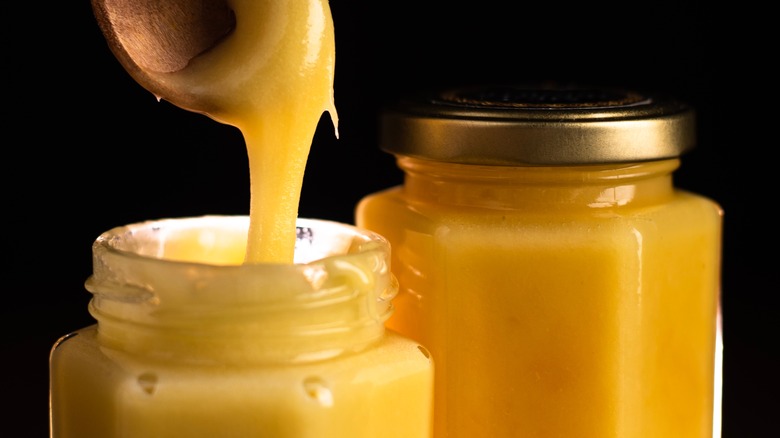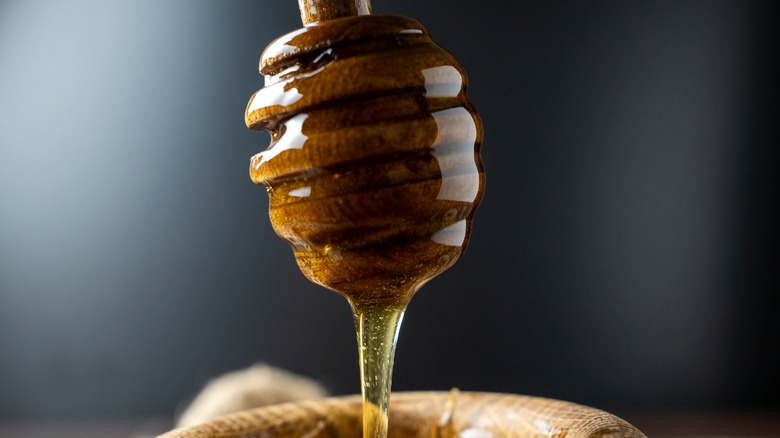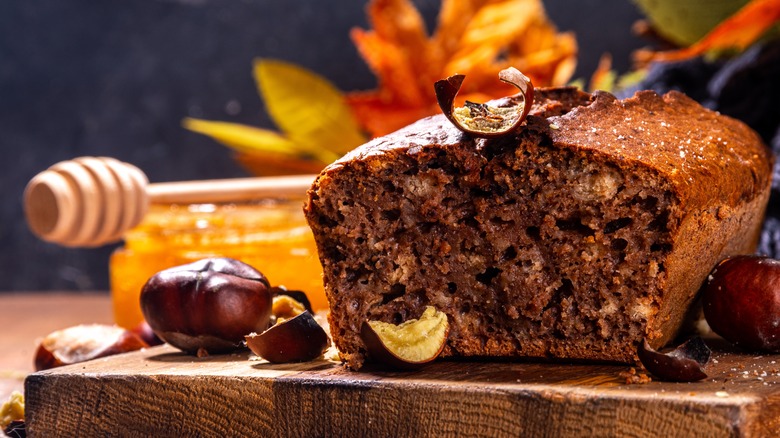The Best Tip For De-Crystallizing Honey Is Easier Than You Thought
Honey never goes bad. In 2015, archaeologists found 3,000-year-old honey in an Egyptian tomb — and it was still (supposedly) edible. Because of its low water, high sugar content, it's an inhospitable environment for bacterial growth. But it can crystalize, and while that can be a major pain, it doesn't mean you need to throw it away in favor of new honey.
Like your tired muscles, honey will relax in a hot water bath. A study published in the December 2020 issue of Innovative Food Science and Emerging Technologies recommends heating crystallized honey at 95 to 105 degrees Fahrenheit for 20 to 30 minutes.
Place your jar of honey into a heatproof bowl and bring some water to a boil in a pot or kettle. Once it reaches a boil, pour the water around the jar and let it soak until it de-crystallizes. (The time this takes will vary depending on the amount of honey in the jar and how crystallized it is.) You can repeat this as many times as necessary when the honey inevitably crystalizes again. But how do you stop honey from crystallizing in the first place?
Why it happens and how to stop it
Honey is made up of water and two primary sugars: fructose and glucose. It's already a supersaturated solution, and the slightest change in water content or even a drop in temperature can disrupt honey's liquidity. As soon as you open the jar or bottle of honey, its water content starts evaporating and the glucose molecules begin to bind together, thus crystallizing the honey.
It's natural — honey will even crystallize in the hive if the temperature dips below 50 degrees Fahrenheit. Some honey producers prevent future crystallization of the product by pasteurizing it. Most commonly, this is done with thermic treatments either by heating to 160 degrees Fahrenheit or freezing to -40 degrees Fahrenheit. If honey crystallizes, it's a sign that it is a natural, raw product. To maintain these properties, don't heat the honey to 160 degrees Fahrenheit or above.
The chefs at America's Test Kitchen found that doctoring the sugar composition of the honey can prevent crystallization by adding two teaspoons of light corn syrup per cup of honey. The corn syrup contains fructose and glucose, too, but it also contains maltotriose, another type of sugar with longer molecules. The maltotriose blocks the glucose from locking together, stopping the honey from recrystallizing.
Can you use crystallized honey?
Short answer: yes. Longer answer: Although you can use crystallized honey, it's harder to spread (and certainly won't drizzle) when it's crystallized. Moreover, it won't incorporate into baking recipes properly if it's crystallized, spelling disaster for your gluten-free cornbread recipe.
If you're cooking with crystallized honey in a way that's going to heat it, the crystals will dissolve in the process. Stirring crystallized honey into coffee or tea will be just fine, for the same reason. Recipes such as this strawberry ricotta toast, though, will suffer without first de-crystallizing the honey — not only because the honey won't properly coat the strawberries, but also because it will leave a grainy, unpleasant mouthfeel in the toasts.
When starting a recipe that needs honey, pull the jar out of the cabinet before starting anything else. If it's crystallized, draw it a nice warm bath and set it aside; by the time you're ready to use it, the honey will be golden and liquid again.


